Engineering leaders usually outsource quality assurance (QA) to a software testing service to reduce developer workload, accelerate releases, and avoid the complexity of in-house QA teams.
However, many engineering leaders mistakenly assume outsourcing automatically solves test creation and maintenance burdens and guarantees faster shipping. In reality, choosing the wrong service can exacerbate these problems.
Many services write fragile tests that depend on unstable areas of the codebase, like IDs or class names. A small change — such as renaming a button’s ID from “checkout” to “purchase” — can break these tests, even if the UI still functions correctly. As a result, each change means software development teams face delays while waiting for external test personnel to fix test scripts.
Additionally, these tests often verify the code rather than the actual user experience. Tests might pass just because a login button exists, even if a popup is blocking it from being visible. This leads to broken user flows despite tests indicating everything is fine. (We discuss how this happens in more detail below.)
In this article, we delve in-depth into how Rainforest QA, our software testing service, addresses these issues.
Reach out for a quick demo to learn how Rainforest can help you outsource QA and avoid the limitations of most services.
1. Rainforest QA
AI-powered software quality assurance services built to improve shipping velocity

Rainforest QA is our quality assurance testing service. We use our proprietary testing platform and virtual machines (VMs) to write and run automated tests, ensuring both the functionality and visual layer of your application are working as intended.
Below, we’ll dig into how we:
- Create tests 3x faster than writing code while automating test maintenance
- Produce more reliable test results by validating your application’s UI directly
- Test anything that appears on the screen, even user flows outside the browser
- Integrate into your team like a full-time QA engineer
- Offer automated and manual testing services from within one platform
Rainforest’s AI automatically updates tests for intentional UI changes
As we alluded to in the previous section, many QA services write tests that are anchored to fragile code details, such as element IDs.
Even a minor change, such as renaming a button’s element ID from “submit-form” to “send-data,” can cause tests to fail because the test is still looking for “submit-form.” This occurs even if the button works perfectly and looks the same on the UI. Software quality assurance teams then wait hours or days for external QA to fix scripts, stalling deployments.
Rainforest tests are more resilient because we validate the application’s visual elements, not code identifiers. For example, if a “Submit” button’s ID changes from “#submit-btn” to “#send-data,” but the button still appears as “Submit” on-screen, Rainforest’s test passes — it interacts with the visual layer, not the code.
To reduce noise from intentional UI changes, our patent-pending AI, trained on thousands of tests, understands whether the change aligns with expected updates. If intentional, the AI updates the test automatically. If the AI identifies a discrepancy, it flags the issue for your test manager to review.
Our AI ensures tests adapt to intentional UI changes without test managers having to jump in and rewrite scripts all the time, allowing you to ship code faster.
Read more: Top 5 regression testing services & key factors to consider
Writing tests in Rainforest is 3x faster than code
Many QA providers write tests in code — a time-consuming and inefficient approach. Every test requires manual coding of elements and actions. Reusing test steps across workflows is also difficult, forcing engineers to rewrite scripts from scratch. This is another reason why many QA services frequently halt the release of new features.
Rainforest accelerates test creation by replacing code with plain English. Test managers describe user flows like “Click the login button” or “Enter a valid email,” and Rainforest’s AI generates the corresponding test scripts. As a result, we can create tests 3 times faster than services writing code.
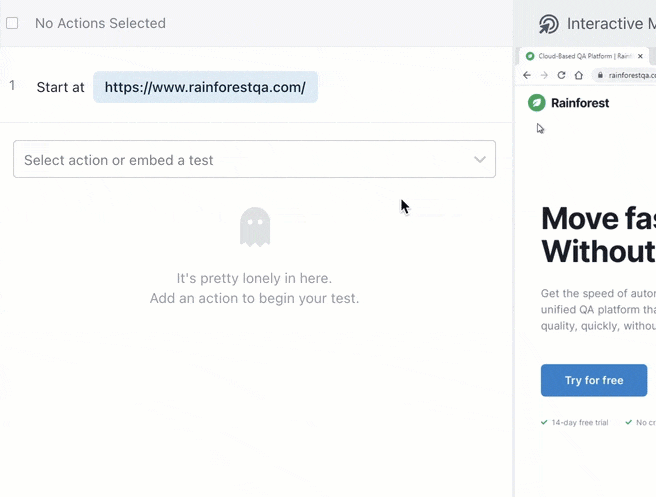
To speed up testing further, Rainforest provides pre-built datasets (including names, addresses, and payment details) and reusable workflows. For example, a checkout can be copied into multiple tests. If the checkout process changes, updating it once automatically applies the change everywhere it’s used.
By eliminating the need for manual coding of test steps, Rainforest enables QA to keep pace with rapid development cycles.
Read more: Top 5 functional testing services & what to look for
Rainforest detects visual bugs code-based tests often miss
Another limitation of testing code is that it isn’t the most reliable way of validating what users see. In many cases, an element may exist in the code and seem to function correctly, yet the UI still contains obvious visual bugs.
For instance, consider a login button with the code identifier #login-button. Traditional QA services create tests that verify the button exists in the DOM and can be clicked programmatically. However, if a CSS error pushes it off-screen or a popup obscures it, the test still passes; the code element exists, even though users can’t see or interact with it.
Rainforest tests a software application’s visual layer directly by running tests in VMs, which behave like actual devices and use image recognition technology to interact with visual elements like a human tester would.

So, if a login button is missing or blocked, the test fails, just as a real user would be unable to log in. You can be confident that the interface functions exactly as intended.
Rainforest tests user flows beyond the browser window
Many testing services can’t validate actions outside the browser — such as downloading files, installing software, or interacting with system-level features — because they rely on outdated testing tools (e.g., Selenium, Playwright) that only test within browser windows.
This creates blind spots where bugs can slip into production, even if the browser-based flow works perfectly.
Rainforest QA can test anything visible on the screen by running tests in entire VMs, including workflows spanning multiple applications or system interactions.
For example, we can test completing a purchase in your web application, downloading the invoice, opening it locally, and verifying that the payment details match the order.
Dedicated test managers integrate with your team’s workflow
Outsourced software QA services often fail to integrate as closely into your team as a full-time hire for multiple reasons:
Rotating testers create knowledge gaps, forcing engineering leaders to repeatedly explain workflows, quality standards, testing strategies, time-to-market objectives, and priorities to new team members. Each new tester resets progress, delaying releases.
Testers are based overseas, don’t speak fluent English, and work outside your time zone. As a result, it’s impractical for them to join team meetings and work closely with developers like internal hires.
Rainforest avoids knowledge gaps by assigning two dedicated test managers to your account. They integrate into your workflows like in-house hires, learning your application’s unique requirements and testing goals. While initial onboarding is required, their knowledge of your application grows over time, reducing the need for ongoing oversight.
Rainforest’s test managers work in your time zone and communicate in fluent English, eliminating delays and collaboration issues caused by mismatched schedules or language barriers.
Case study: How Rainforest QA became a “game-changer” for Push Security’s QA initiatives
Rainforest makes it easy for developers to find and fix bugs
Most QA services alert developers to bugs but leave them to hunt through code for the cause. This delays fixes as engineers spend hours recreating issues or parsing logs to find root causes.
Rainforest accelerates debugging by attaching actionable evidence to every failure. When a test detects a bug, it auto-generates a ticket in your project management tool of choice (e.g., Jira) with a video of the exact steps leading to the failure.
Developers see which test step broke, the browser or device used, loading metrics, and even HTTP logs — no guesswork is required.

For passed tests, Rainforest provides the same level of transparency. Every test run includes video recordings and logs, proving that validations occurred in real-device environments.
Non-technical stakeholders can also review results. Tests are written in plain English, and the platform highlights failed steps in red. Product managers or executives quickly grasp issues without needing to decode technical reports.
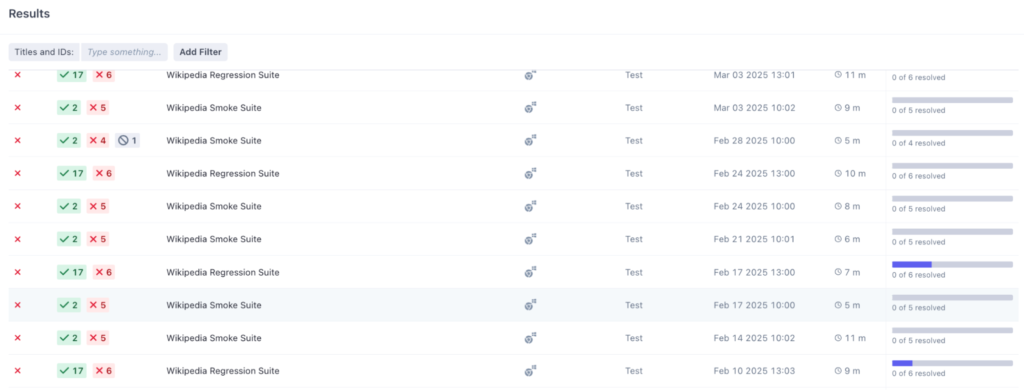
Rainforest cuts resolution time by replacing vague alerts with visual, step-by-step evidence and keeps teams aligned. Developers fix bugs faster, and releases stay on schedule.
Combined automated and manual testing for comprehensive coverage
Automated testing excels for stable workflows, but manual testing remains critical for early-stage features or unconventional user paths. For example, a partially built UI might change daily, breaking automated scripts, while edge cases (e.g., rare payment errors) require human intuition to uncover.
Rainforest combines both approaches on a single platform. Test managers create manual tests using plain English instructions, which are executed by a global crowd of testers. Results, including video recordings, arrive within 17 minutes — even after working hours, on weekends, or holidays.

To ensure manual testing accuracy:
- Tests run on clean VMs, eliminating device-specific false positives.
- Two testers validate each script. If results conflict, additional testers resolve discrepancies.
- Most testers have five or more years of experience working with us.
This hybrid approach lets teams validate their application without maintaining separate tools or teams for manual and automated QA.
Cost-effective test coverage scaling without hiring in-house engineers
Book a demo with our team to learn how our QA testing services can fit your testing needs.
2. Qualitest
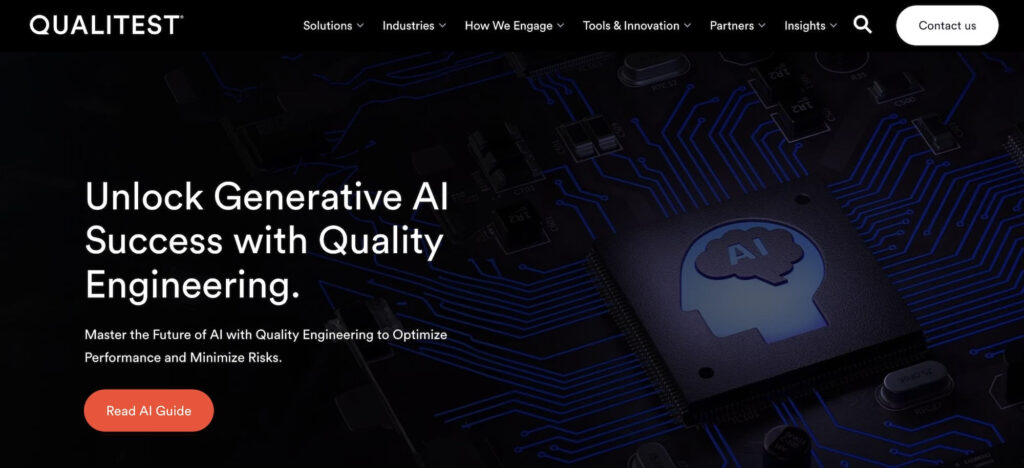
Qualitest is a quality assurance company that provides end-to-end software testing solutions across industries, including healthcare, e-commerce, and finance.
Their service offering is broad, covering automation testing, cybersecurity, load and performance testing, ETL validation, CX/usability, and regulatory compliance (including FDA and GDPR).
The company emphasizes domain-specific expertise by combining QA engineers with development process consultants to ensure that testing contributes to measurable ROI. It also leverages strong partnerships with enterprise software providers to stay ahead of upcoming release cycles.
That said, Qualitest’s solutions often rely on AI-led automation and open-source frameworks. While it’s effective for process and code validation, it may be less focused on real-world UI behavior unless combined with additional layers of testing. This makes it ideal for enterprise environments seeking scale and compliance, but potentially less tailored for consumer-facing products needing high-fidelity UI insights.
3. QA Source
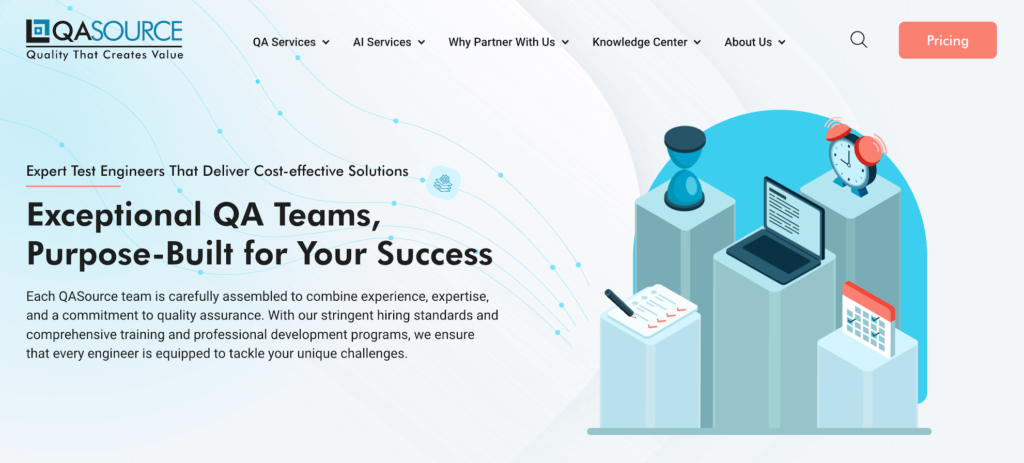
QASource positions itself as a scalable QA consultant and partner capable of integrating seamlessly with client development teams. They offer different types of testing services, such as manual testing, automated testing, IoT testing, security testing, compatibility testing, penetration testing, unit testing, and more.
The company emphasizes custom solutions, advanced infrastructure, and a collaborative model that blends offshore delivery with onshore client engagement.
QASource highlights its flexible engagement models, claiming to offer both cost efficiency and enterprise-grade quality. However, like many traditional QA service providers, its approach often relies on code-based automation frameworks and manual testing workflows — methods that may not always replicate real-world user interactions as directly as newer UI-focused platforms.
Ultimately, QASource caters well to organizations seeking a comprehensive, traditional QA solution with the ability to scale teams and integrate across technologies, though companies looking for faster, UI-level comprehensive testing at scale may find more agile alternatives.
4. QAMentor
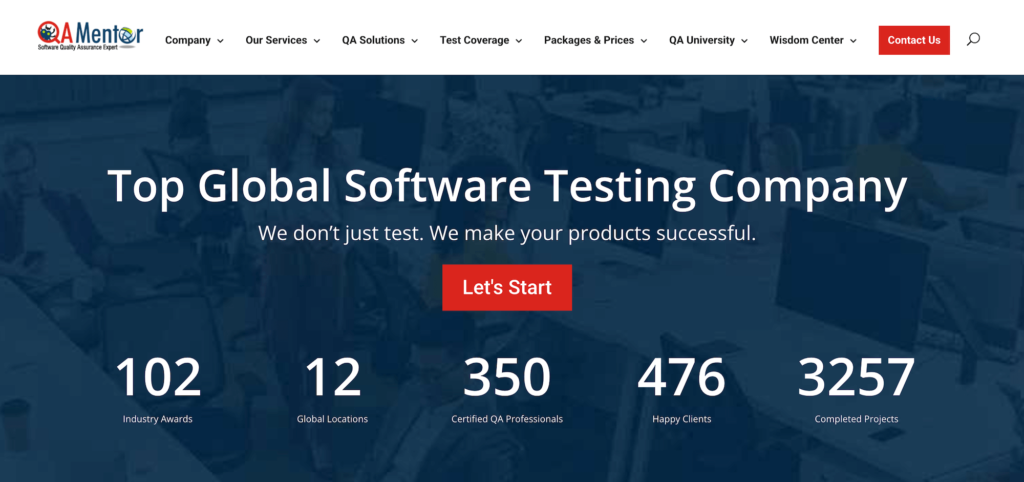
QA Mentor is a global, high-quality software company headquartered in New York and operating across 11 global locations. The company supports clients ranging from startups to Fortune 500 firms with both onshore and offshore QA teams.
What differentiates QA Mentor is its sheer breadth of services and certifications. It combines ISO standards, CMMI appraisals, and an expansive global tester base to position itself as a comprehensive QA vendor. Its crowdtesting network spans 123 countries, although unlike platforms focused on UI testing or real-user behavior, QA Mentor’s crowd is made up of testing professionals rather than general users.
Still, QA Mentor relies heavily on traditional testing frameworks and tooling, similar to other firms in the category. While their methodology is robust, it’s grounded in conventional automation practices and doesn’t necessarily offer the type of real-time UI testing or scriptless automation seen in more modern, AI-driven platforms.
5. A1QA
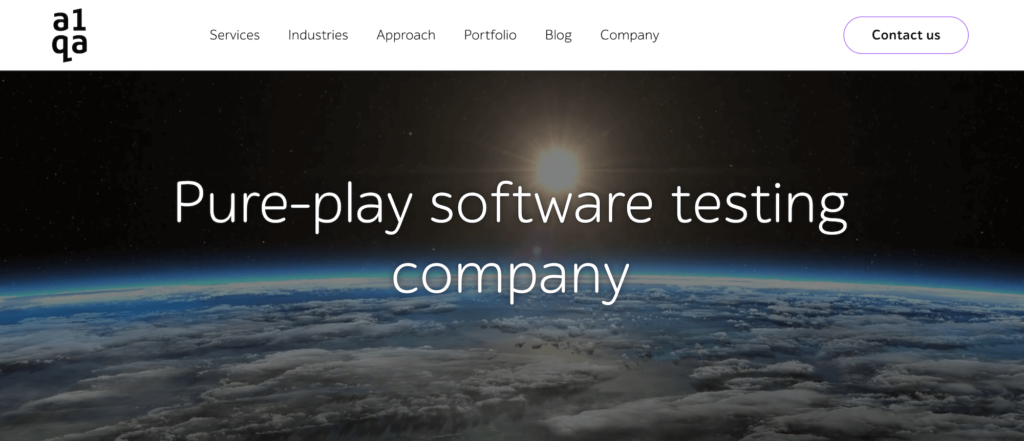
a1qa is a pure-play software testing company that has been operating since 2003. The company positions itself as a global provider of end-to-end quality assurance services. a1qa offers a wide range of functional and non-functional testing services, with coverage spanning from traditional web and mobile applications to more complex systems like embedded software, blockchain platforms, and IoT solutions.
a1qa promotes a structured and methodical approach to QA, leveraging internal R&D and Centers of Excellence to stay updated with best practices and emerging tools. While the firm markets its global delivery model and around-the-clock testing capabilities, its methodology tends to rely on conventional testing techniques, frameworks, and practices that are shared across many providers in the space.
Although a1qa supports DevOps and shift-left testing strategies, their reliance on traditional automation frameworks may limit the speed or flexibility offered by more modern, UI-focused solutions. For teams looking for tightly integrated, no-code, or UI-first testing workflows, a1qa’s approach may require additional internal overhead or customization.
Overall, a1qa provides solid, enterprise-grade QA services for organizations that value structured testing processes and broad technical coverage. However, for companies looking for faster iteration cycles or more modern QA tooling, alternatives that offer more lightweight or UI-native testing approaches may be worth considering.
6. QualityLogic
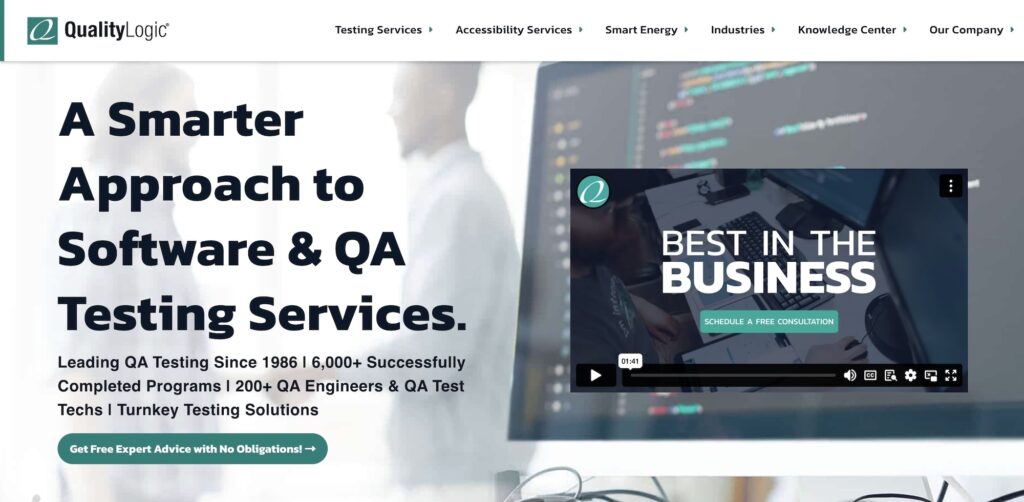
QualityLogic is a U.S.-based QA and software testing company with over three decades of experience. The company offers a broad suite of testing services, including manual and automated QA, performance and usability testing, digital accessibility, and even specialized testing for smart energy and connected devices. Their value proposition centers on customizable QA solutions, onshore expertise, and rapid deployment.
While QualityLogic highlights their long-standing industry presence and U.S.-based teams as advantages over offshore alternatives, their approach still leans heavily on traditional QA workflows. They position themselves as flexible partners capable of integrating with agile environments, but much of their value depends on manual coordination and team-based execution.
The company does offer some on-demand testing and hybrid resourcing, mixing onshore management with offshore testers. Still, this model can introduce variability in execution speed and cost-efficiency, especially when compared to newer platforms that emphasize instant access to testers or no-code automation.
Ultimately, QualityLogic is a solid choice for organizations seeking a consultative, hands-on QA partner with U.S. support. However, for teams prioritizing speed, scalability, and UI-level automation without the overhead of conventional QA teams, other solutions may offer greater agility and cost performance.
7. DeviQA
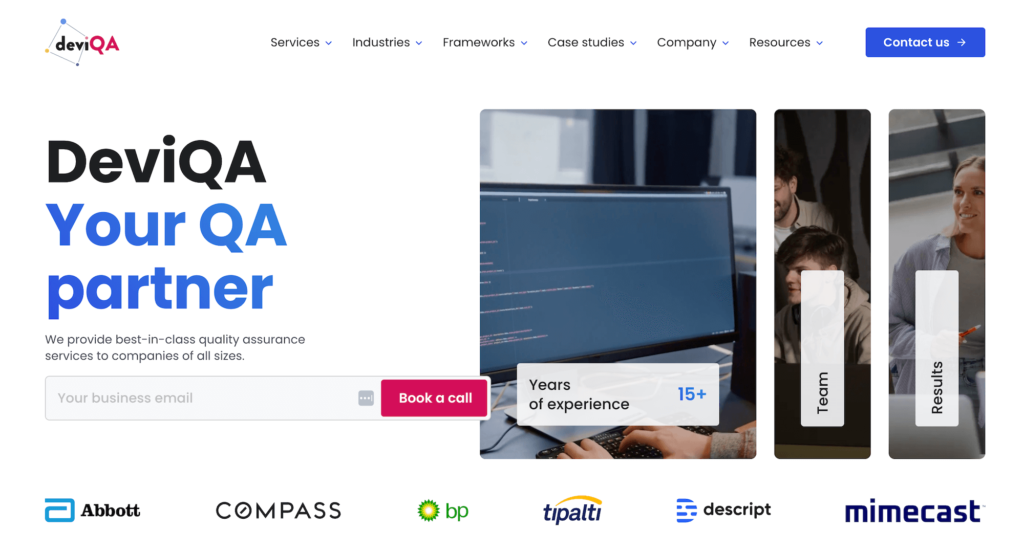
DeviQA is a quality assurance company offering a wide range of software testing services, including QA outsourcing, consulting, and managed solutions. With over 15 years in the industry and a team of more than 250 QA engineers, DeviQA positions itself as a scalable testing partner for companies of all sizes.
The company supports multiple cooperation models — from full QA team augmentation to fully managed remote QA departments. Its services cover functional testing, automation, performance, and API testing, among others. DeviQA also offers a free proof of concept, aiming to reduce onboarding friction for prospective clients.
A notable aspect of their offering is the integration of AI across their QA processes. Their in-house AI tools assist with test case creation, code reviews, exploratory planning, and log analysis, all aimed at saving time and optimizing QA workflows. However, as with many automation-focused QA providers, their approach is primarily code-centric, which may not fully reflect end-user experiences in UI-heavy applications.
